This paper was presented via video at the SHARP Conference in July 2025. The video is posted here, followed by a transcript. A Q&A follows the talk and is transcribed at the end of this post.
I’m Dot Porter. I’m the curator for digital humanities at the Schoenberg Institute for Manuscript Studies and the Kislak Center for Special Collections, Rare Books and Manuscripts in the University of Pennsylvania Libraries. I am sorry I can’t be here in person, but I would like to thank the SHARP organizers for allowing those of us who can’t attend in person to join virtually. So here is my recording of my talk. So thank you.
Coffee with a Codex began as an improvised outreach solution during the COVID-19 pandemic. Launched by me in January, 2021 at the University of Pennsylvania’s Schoenberg Institute for Manuscript Studies, Coffee with a Codex offers a weekly, 30 minute informal Zoom session featuring primarily medieval and early modern manuscripts. The concept was and is simple: a book, an overhead camera, and a reasonably knowledgeable host, (that’s me) and also sometimes guest hosts who actually know a lot more than I do, which is always great to have. And we engage in spontaneous commentary while turning the pages of the book. It’s basically a show and tell.
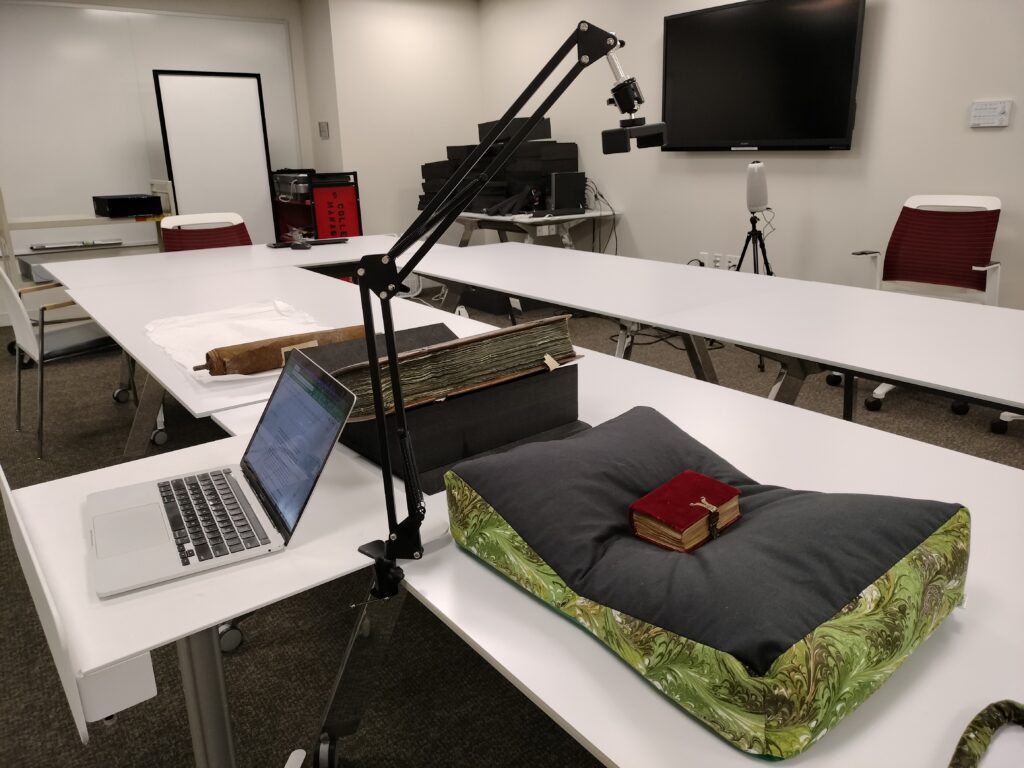
And here is the setup with the overhead camera arm, so you can get a look at what it looks like from my side of things. And here are a couple of shots from when I was with Sophia Adams, who was a visiting scholar and she was looking at this 15th century prayer roll. And this is a view from a camera that’s in the room.
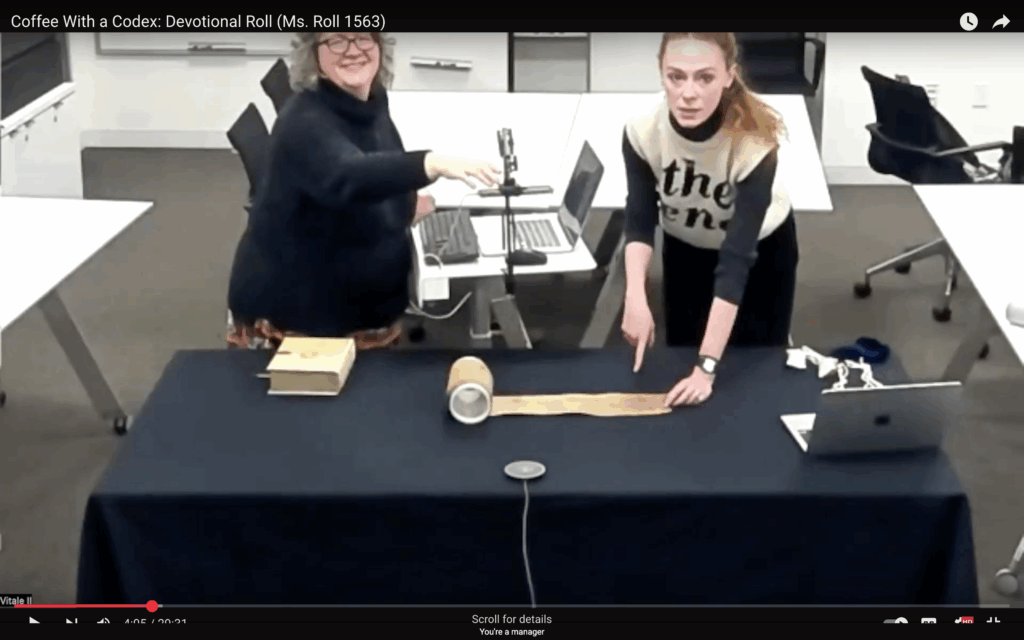
And it’s just sort of showing us as we’re doing setup. And then when we switched to the camera view, here is what the camera saw.
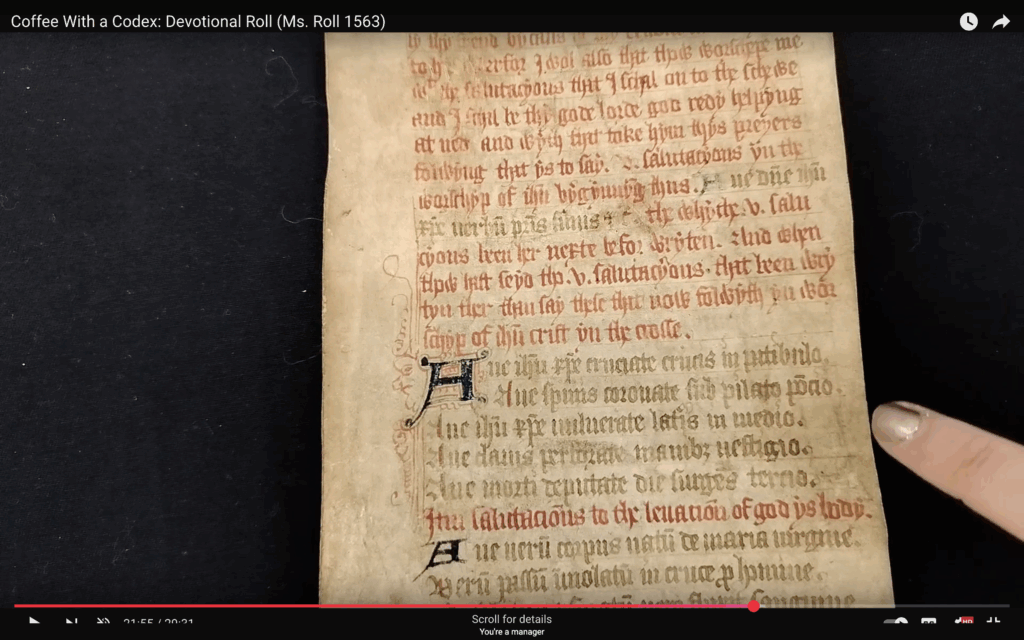
So you get in that case, both the far away and the close up. But this is what view looks like when we’re the program.
Now in its fifth year, the last four having been recorded with videos posted to YouTube and made available in the past events area of the webpage, Coffee with a Codex has grown into a fixture for a loyal group of manuscript enthusiasts, drawing between 25 and 40 attendees each week, depending on the topic of the manuscript. Many of these people are regulars.
In contrast to highly produced asynchronous content, Coffee with a Codex emphasizes synchronous, intimate, real-time engagement. But perhaps most notably, it has fostered a sense of community among an audience that spans disciplines, professions, and continents. This paper examines Coffee with a Codex through the lens of its 2024 participant questionnaire, focusing on how viewers experience the program and how they perceive its community aspects. The findings reveal not only deep appreciation for the program’s content and delivery, but also a strong sense of belonging and shared purpose.
Coffee with a Codex emerged from a long-standing SIMS commitment to integrating manuscript studies with digital engagement. Previous initiatives like Video Orientations, these are two to three minute videos that are posted to YouTube and also linked to our catalog records, which provide brief formal introductions to manuscripts. And Virtual Classroom Visits, virtual in-person curated manuscript visits with classes. Had already tested methods for remote object-focused teaching. But the pandemic, with its widespread restrictions on physical access, created both necessity and opportunity. Coffee with a Codex was built on that foundation, a lightweight, scalable, and personable format made possible by institutional support, smartphone cameras, and the willingness of myself and my colleagues at SIMS to be open to what was, at the beginning, very much an experiment. As my colleague, Nick Herman, Schoenberg Curator of Manuscripts, and I describe in our co-authored chapter in Mobile Heritage, which was published this year, “Coffee with a Codex represents a shift in manuscript outreach. Rather than relying on two-dimensional facsimile databases, which we also have many of at SIMS, the project returns attention to the physicality of the book, its weight, movement, texture, and sound. In doing so, we challenge the assumptions about access, audience, and authority.
Coffee with a Codex differs significantly from asynchronous content. It is ephemeral, participatory, and anchored in shared time. Its low threshold design, that is free registration, no prior experience, and short sessions, opens manuscript experiences to broader audiences. Participants are invited to type questions in the chat, which I repeat for the camera. As the recordings on YouTube don’t include the chats, neither do they include the attendees’ video and answer as I can. And here is the saved chat from our most recent event from last week.
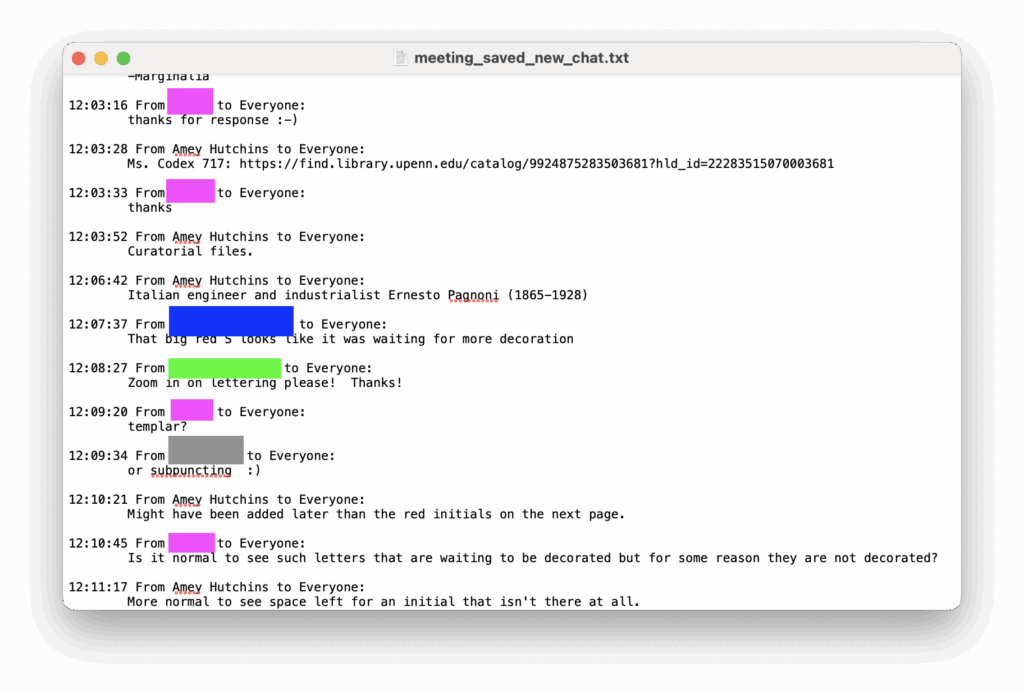
And I’ve color coded the bars that are covering up the names. So you can see that there is one person. This was actually this person’s first time attending. So he had a lot of questions and a lot of things to say. You can see my colleague, Amey Hutchins, Manuscripts cataloging librarian, she attends sort of as my assistant and she’s there answering questions and then a couple of other people are chiming in and we have beginners. We have people saying things like that big red S looks like it was waiting for more decoration because we had a sort of, you know, lonely looking red colored initial with a lot of space around it. We’re trying to figure out what’s happening. Um, here’s someone asking me to zoom in on the lettering because we do have folks who are very interested in the letter forms and want to see that, so there’s a wide variety of folks and I’m very welcome to like comments and questions on this sort of thing. It’s one of my favorite, actually favorite parts of the event. But as one viewer wrote in response to the questionnaire, “I am not in the library or manuscript worlds, but I love the history of books and manuscripts.” That statement is emblematic of Coffee with a Codex’s power to welcome the curious and not just the credentialed.
So the 2024 Coffee with a Codex questionnaire was distributed via the program’s mailing list in the last months of the year. It included multiple choice and open-ended questions about attendance habits, asynchronous viewing, interest in online communities, preferred platforms and reflections on the program itself.
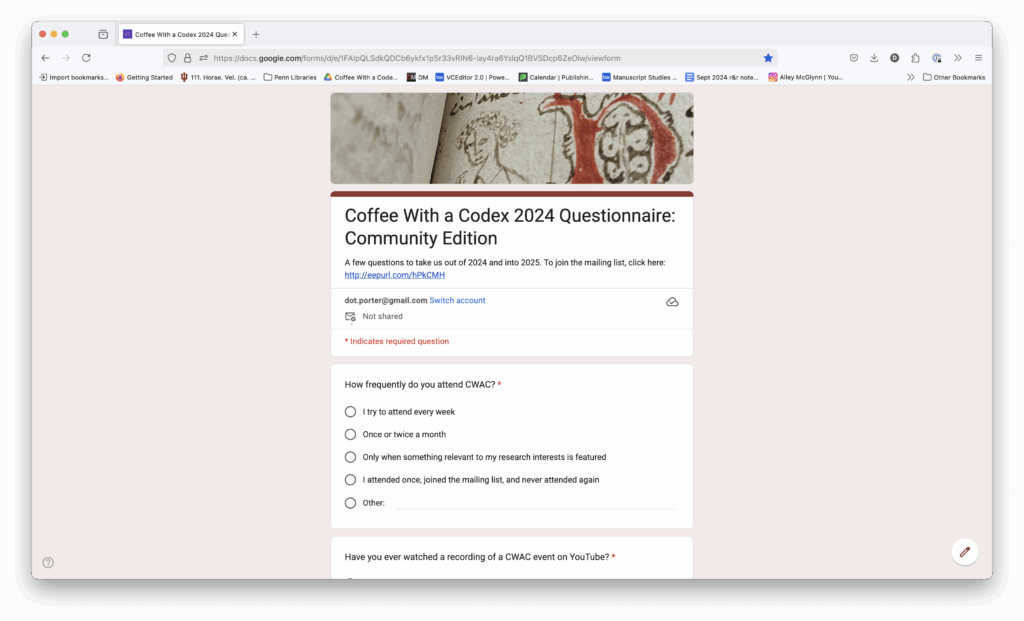
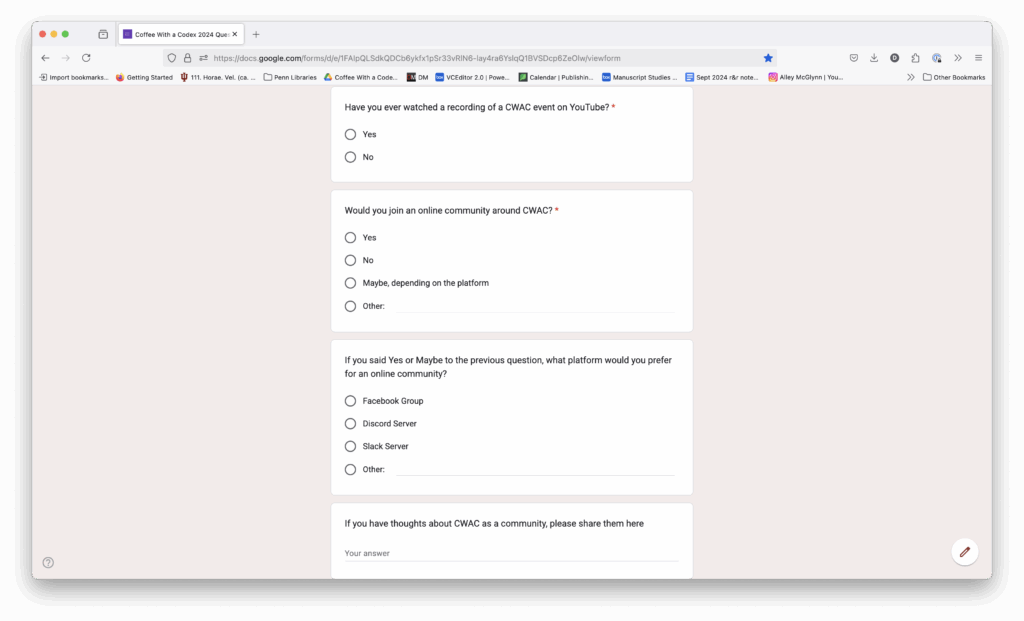
In total, we received 60 responses. This represents a self-selected group, many of them longtime participants. So the results aren’t statistically representative, but I really wanted to just hear what people had to say. The range and richness of the qualitative feedback provide valuable insight into the affective, intellectual and communal dimensions of coffee with a codex.
So what are some findings?
So the rest of this is basically going to be quotes, quotes from people, which is great. Participants frequency of attendance varied with most describing themselves as regular but flexible viewers. So Here are some examples. I try to attend when my schedule allows. I’m not able to attend as often as I would like. I wish I could come more often. I’m the department head. We all know how that is. As a full-time medical school faculty member, it’s hard for me to make all the talks.
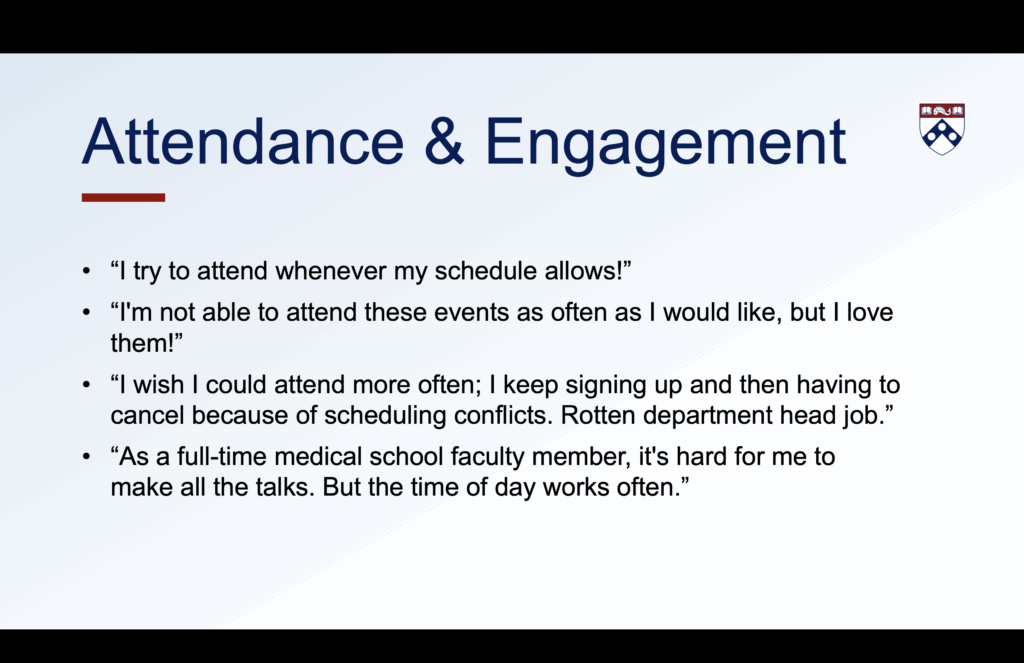
And that’s also nice to see, right? Because a medical faculty member is not, that’s not English, it’s not art history, but they’re still interested in coming and I love that. This variability underscores the value of the recordings which some participants watch.
When live attendance isn’t possible, although the responses imply that we need to do better maybe with marketing the videos as an extension of the live sessions. So I think the recordings are good when I can’t come. And then here’s this responder who didn’t even know. I didn’t I know you’ve had recordings on YouTube and I’m going to check them out.
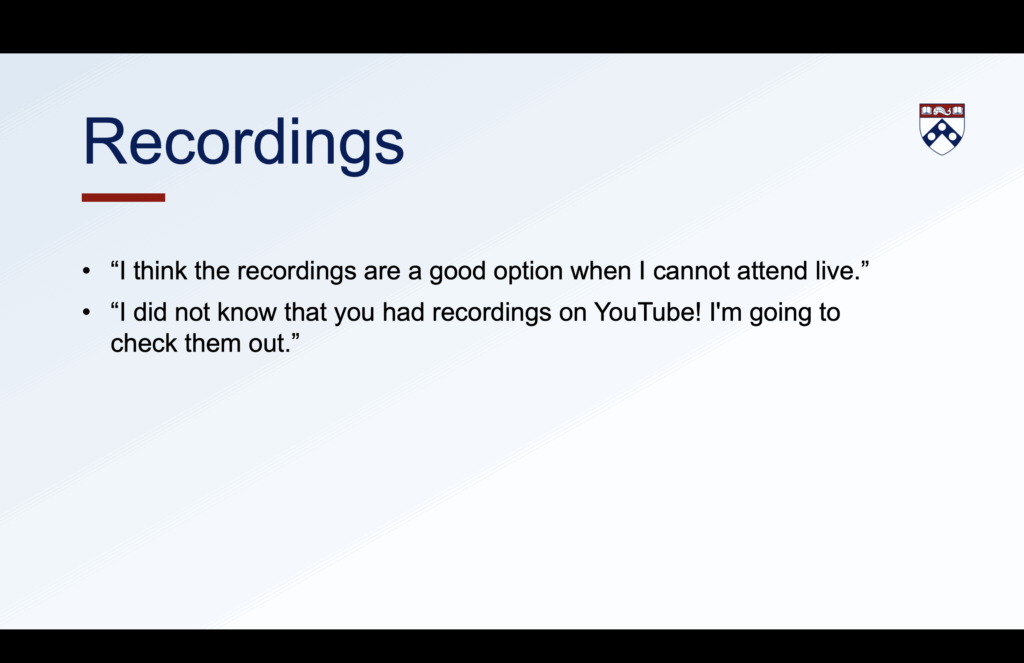
Respondents overwhelmingly affirmed Coffee with a Codex as a meaningful community experience. There were a lot of these. I love it. I feel like I’m part of a group that shares the same love and passion for rare materials as I do. An intelligent, cordial gathering. Most welcome. It’s lovely. That and Amey are a wonderful team. I look forward to this presentation. I like it as a gateway to a much needed weekend. Some participants also articulated a desire to grow the community. I am a 2025 MLIS candidate. I love it. You’re doing a great job. I tell my classmates. I tell librarians. I tell archivists. I want everybody to come. I belong to two international interest groups. I encourage you to test options for growing and keeping younger followers.
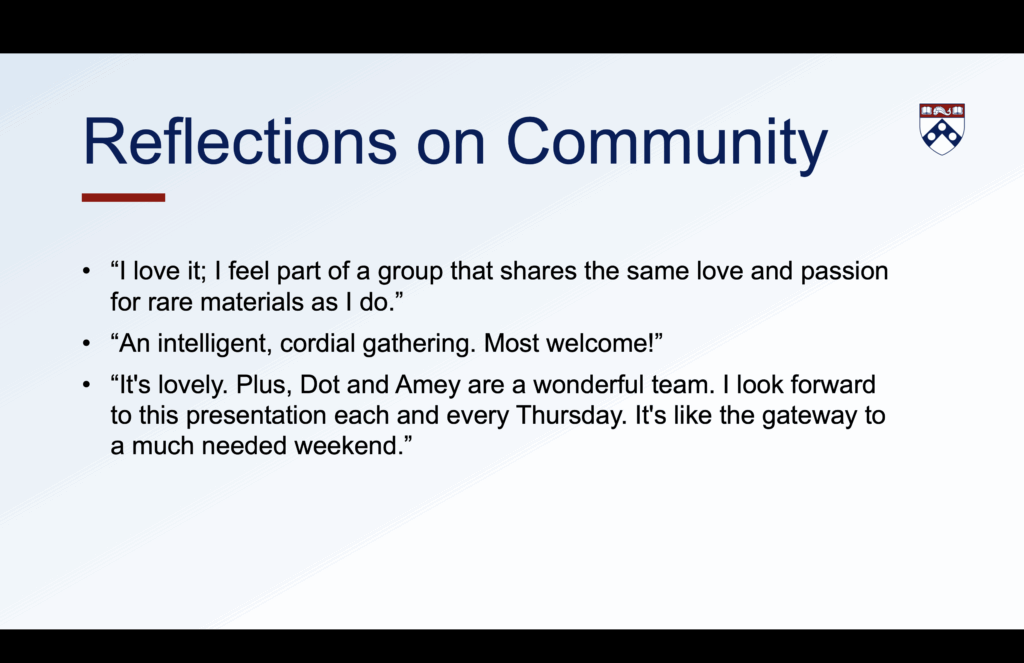
And yes, this is something I really want. People to come who are sort of new to manuscripts, and I want them to feel welcome, so that’s nice to see. Thank you for this wonderful program. It is appreciated that you have this group, and I have shared it with various friends.
Others expressed appreciation for Coffee with a Codex’s educational value. I look forward to these friendly meetings, which enrich my own research. And some framed the experience emotionally. Being transported each week to another country and century is wonderful. It puts the hardness of current events into some perspective.
And that is particularly nice to see because the world is really terrible right now. And my response to that has been to focus on bringing joy where I can. Not that I’m ignoring what’s happening in the world, but maybe for a half hour, we can focus on something that’s beautiful. And so I like to see that other people are doing that too. And then, of course, I love Coffee with a Codex. It’s such a lovely break in the week.
The responses suggest that Coffee with a Codex has grown beyond its original format into what we are defining through this session as a community of the book, a group formed around shared engagement with physical books. This, I think, makes Coffee with a Codex community distinct from Brian Stock’s textual communities, which I read a little bit about as I was preparing this. I didn’t think it really fit, but that’s nevertheless an obvious comparison that may be worth further analysis. Participants are not just watching. They’re participating in a ritualized event guided by an expert and joined by others who return week after week.
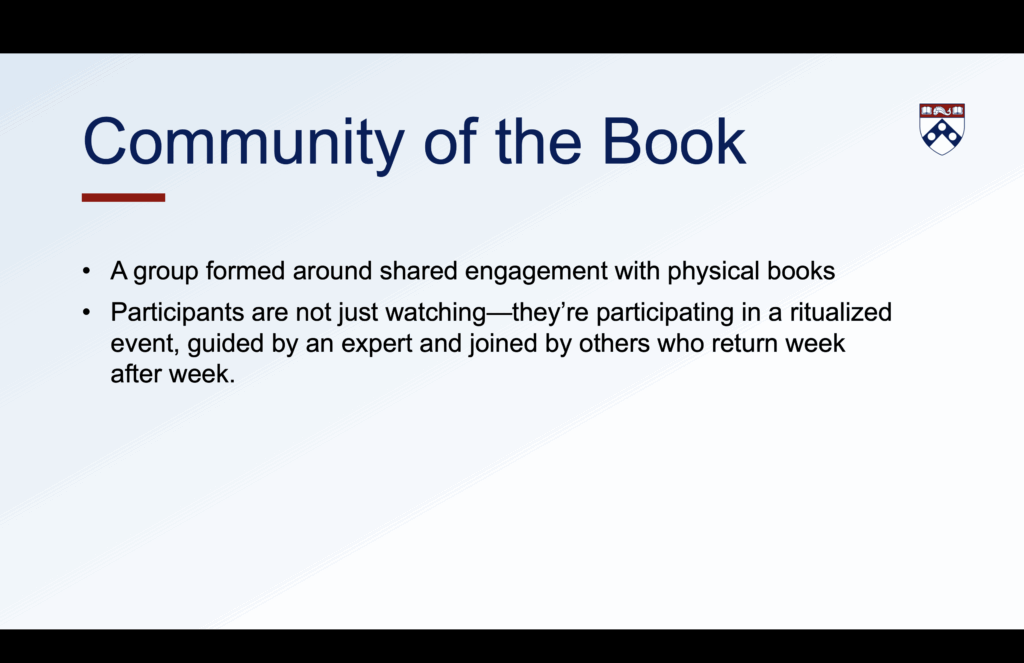
Importantly, I think, Coffee of the Codex attracts both traditional and non-traditional audiences, including attendees with creative rather than scholarly interest in manuscripts. Several respondents identified themselves as calligraphers, bookbinders, or artists with specific interests in material and visual details. So here are a couple of quotes from them. I’m a calligrapher and bookbinder, so seeing the letter forms is nice. And I always, I do, I talk about the bindings. I’m always pointing out things with that because I’m very interested in structure. I’m calligrapher and the letterforms are a major interest. And then I love seeing the art and the marginalia and the creatures. We don’t actually have a whole lot of manuscripts like that. But when we do, we look at them and that’s great.
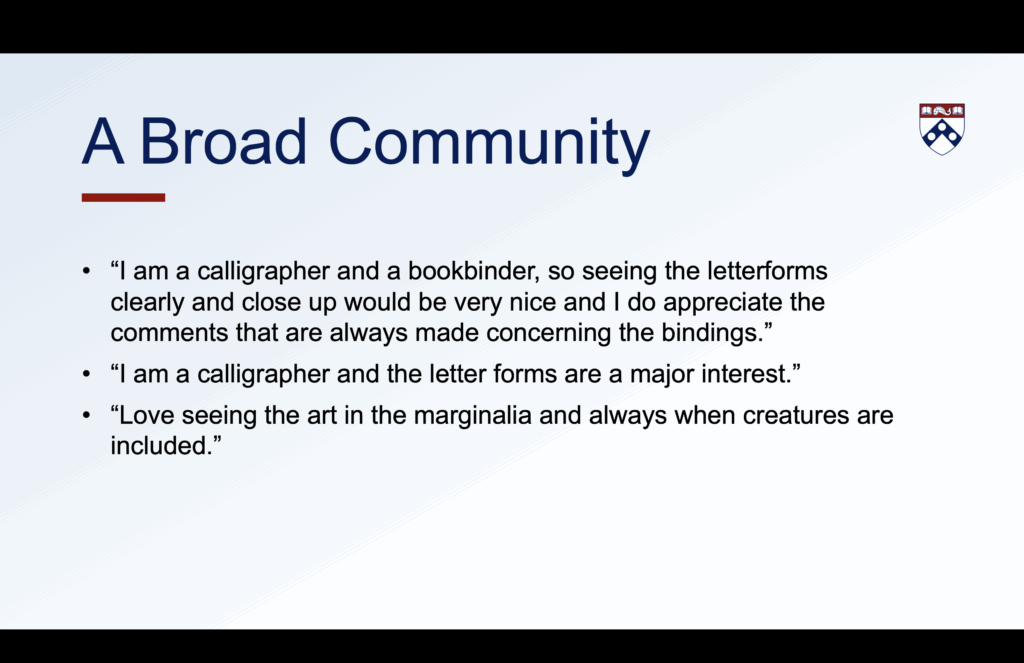
These specialized comments demonstrate that Coffee with a Codex offers not just access, but also inspiration, potentially sparking new questions and creative applications. The community appears to be intentional and sustained rather than incidental. The program’s format, which is live, unscripted, personable, is designed to foster trust and continuity. As host, I am not a disembodied narrator but a regular presence, and the objects are not abstractions but are touchable and audible things.
In the 2024 questionnaire with a view towards expanding the community out of the weekly Zoom events, I asked about interest in community platforms, specifically Slack, Discord, or Facebook groups. There was definitely interest, but no clear consensus. One respondent wrote, I only know Facebook. I suggest you go with whatever is more likely to attract the largest number of participants. Yes, which is smart, especially among students and up and coming professionals. And then another cautioned, I would vote for Facebook, but since the last turn to the extreme, right? I don’t intend to use the platform. The other two, I don’t know.
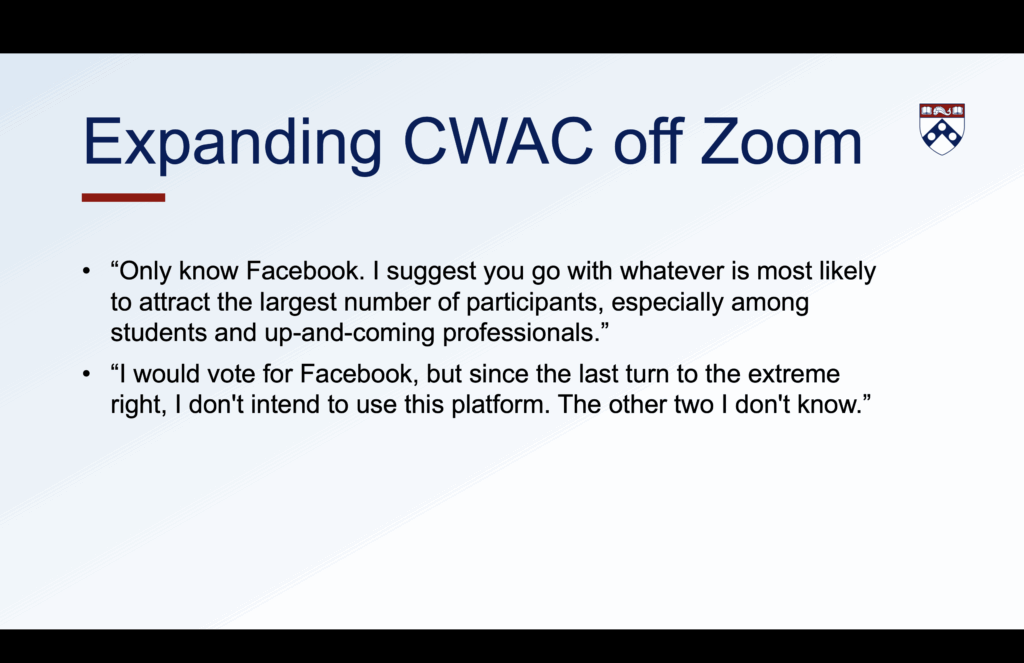
This reflects a broader digital challenge, how to build community in a fragmented platform ecosystem, especially when we do have these sort of political concerns about what these platforms are supporting. Um, so we haven’t moved forward with any platform, although I am still interested in the possibility of doing this. And I think there would be a welcome in our, um, regular community as well.
I also think there are broader implications for Coffee with a Codex. It offers a compelling model for other institutions. It’s a repeatable, low cost, high touch format for engaging communities with rare materials. Its success depends not on scale, but on presence. The act of showing up each week to handle a book with care on camera for whoever wants to look.
In conclusion, Coffee with a Codex began as an emergency workaround and evolved into a beloved program with a committed audience. As the 2024 survey shows, Coffee with a codex isn’t just about manuscripts. It’s about people. It has created a rare space for shared looking informed listening and quiet joy. One participant summed it up very well. Your tireless dedication is much appreciated. Please don’t stop. I love it, and I’m not going to stop. So thank you very much for listening.
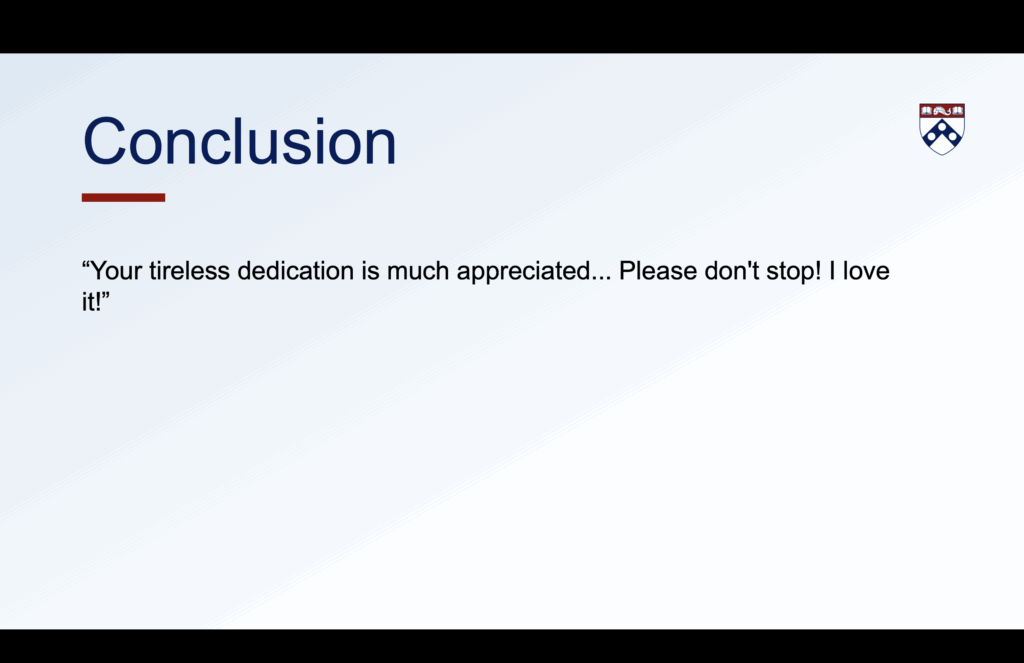
Q&A
Hi, everyone. I’m sorry I can’t be there in person to answer questions. So I asked Liz and Bridget to send me a few questions, and maybe they’re questions that you have. So I’ll do that now.
The first question, which is a general coffee with a codex question, How do you select which manuscripts to showcase when?
There’s not a lot of science to it. I have a spreadsheet where I put manuscripts as I come across them. Maybe I’ll be doing a virtual classroom visits, or I’ll be doing some other kind of project. I curated an exhibit last year. And as part of that, I looked at a whole lot of manuscripts from the collection, and I added them to the list, and then I just sort of schedule them as they come up. I do try to have a mix in the schedule, so the next couple of weeks I actually had two 15th century Italian manuscripts kind of together. We do have a lot of 15th-century Italian manuscripts in the collection so I guess it’s forgivable, but I try to. Have some variety, especially in terms of cultural background and language and that kind of thing. So I’m not just doing Latin manuscripts all the time. Although this past year, I tried to be a little more systematic. I did a search of our catalog by date of publication, which is the date that we have dated the manuscripts to. And so this year, there were a lot of early manuscripts. But again, I tried to mix them up. So you’d have like one of our early Latin ones, and then followed by like one our early Arabic ones, that kind of thing. So but now I’m sort of back to being a little bit more piecemeal, which I think is fine. I don’t, you know, I try not to stress about it too hard, except in terms of being having that variety. I will say, as I have guest hosts, I have I now have some regular guest hosts. So Louis Meiselman is our Judaica cataloger, and he picks his own manuscripts. It’s usually whatever he’s been cataloging. I also have graduate students who have guest hosted with manuscripts that they’ve been working on, so obviously they pick them. And occasionally, my colleague Nick Herman, who’s our curator of manuscripts, he will also pick his own manuscripts. And I like that too, because then I don’t have to be responsible for making the selection. But that’s a good question. So that’s how that goes.
Next question. In the range of people attending, do you find more people wondering about content or is it mostly a materiality crowd? So it’s a little bit leading, like I’m little bit leading because I am a materiality person. And I am not primarily a content person. It’s not a secret. I, and I often say it, like at the start of the event, I’m like, look, like especially if it’s something, like if it was an Arabic manuscript or a few weeks ago, I did some Arabic and Coptic, like I can’t read Arabic, I can’t read Coptic. I can not read a lot of languages. And so if people have like really detailed, if they want to see what a particular page says, I can’t help. Very frequently, there are other people on the call who can, because they’ll come and know more than me, which is fantastic. And so then that can sort of help out with the content part. But I’m very much materiality. If there are folks who are really content, they just have to put up with me talking about materiality, and I think for most people, that’s fine. So as a sort of self self-selects a little bit, and it’s hard for me to say, what people are actually coming for. All right.
Next question. Who are your attendees? Mostly already manuscripts people, or do you find yourself working with advanced professionals and totally untrained lovers of manuscripts? And how do you engage that full range?
I think that presentation actually answered the question. And it is like a broad swathe of experts and also newbies and also artists, which is great. I know that there are some folks from the Society for Creative Anachronism too who come. So it’s a great variety. How do I engage? I think I engage by sharing my knowledge, which, again, tends to be material, and also by making it a conversation. I’m not giving a lecture. I’m like, here’s the thing, ask me questions. And people do ask questions in the chat, as you saw from that one screenshot. You know, there’s very much a question and answer and also sharing knowledge and conversation. And I think that helps a lot. It helps me make people comfortable. Another thing that I do is I’m not afraid to admit when I don’t know something. I think, that’s a really important aspect, being willing to say when I don’t know something. And I think that makes the experts more willing to step up and share. And it makes people who are newbies and maybe don’t know as much feel more comfortable, like, oh, she’s the person who’s leading the event and even she doesn’t like know everything. And I think that can be really helpful. Good question.
So the last question, affect, I love affect. You are an enormous lover of manuscripts as well as highly trained and experienced. How much of that love do you share in Coffee with a Codex versus say Inside My Favorite Manuscript podcast (which is a podcast I hosted a few years ago. I don’t do anymore, sad.) And how do you decide the balance of pleasure and rigor? So I’m all pleasure. It’s all about like, Let’s have fun. I actually think about it as manuscript fandom. I have a long history in fandom, and I do feel like what I do is a type of fandom work. That said, I don’t want to lie about the stuff, which is one of the reasons why I’m not afraid to say when I don’t know something. The thing that I have is I have access. Right, like I am a curator in this library, and we have these incredible collections. And I don’t know everything about everything in the collection, and I don t have to, because I have a camera and I can show it on Zoom. And I feel like that’s the least that I could do. For me, it really is about like sharing this amazing thing that we have with the world, even when I can’t tell you every single thing about it. But the community, you know, that’s sort of where the community can kind of step in. And it’s one of the reasons why I also love having guest hosts who do tend to be more knowledgeable than I am. So that’s really valuable. Yeah, so great question. And I think that was the last one.
So if you have a question that I didn’t answer, if you want to know more about Coffee with a Codex, if you’re interested maybe in setting something like this up at your institution, I would love to That is, yes, dorp at upenn.edu. And again, I’m really sorry I couldn’t be there in person. I’m with you in spirit. And I hope you all have a wonderful day.
